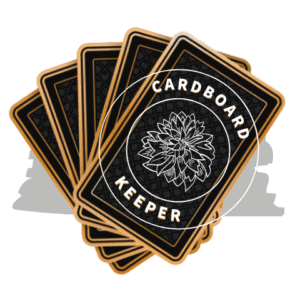Trading card games like Magic The Gathering (MTG) are games I’m glad that I discovered as a child. The real-world cognitive benefits and improved critical thinking skills I developed while learning to play stayed with me into adulthood. With so many of us stuck at home with our families, I wanted to put together something for people who are looking to teach a child Magic The Gathering for the first time.
As a general rule, the best way to teach a child Magic The Gathering is to simplify the game. By reducing the number of Keywords and rule interactions a child has to memorize, children can focus on fundamental gameplay mechanics such as combat and resource management.
There are multiple ways to simplify the game of Magic The Gathering to make it easier for children to learn.
Depending on the child’s age and their natural ability for strategy games, there are elements of Magic The Gathering that you may want to change or completely remove while the child is initially getting to grips with the game.
With that in mind, it’s a good idea to have an understanding of what the recommended age for playing Magic The Gathering is and how that may affect the way you go about teaching the game to a child.
How To Teach Magic The Gathering Kids over 8 Years Old
Depending on the age of your child and depending on their level of comprehension, there are a couple of things you can do to “dumb down” the game of Magic in order for them to start learning and playing as quickly as possible.
Obviously, there will be aspects of the game you will have to leave out, but you will be able to keep the core mechanics of the game the same (turns and combat) and leave out the complicated stuff.
Below I’ve put together some best practices that you can use in order to change the game up a bit in order for your kids to get a quick grasp of Magic The Gathering.
Once they understand the basics, you can implement and reintroduce rules back into the games played with the child to further increase their level of understanding.
Simplifying Magic The Gathering Rules For Kids
These are the rules that you can use to simplify Magic The Gathering for the children you plan to teach, but these are just suggestions, and you can change them and mix them up as you see fit, depending on your child’s comprehension level.
1. Use Mono Colored Decks
Even as an experience Magic The Gathering player, proper resource management can be one of the most difficult skills in Magic to master.
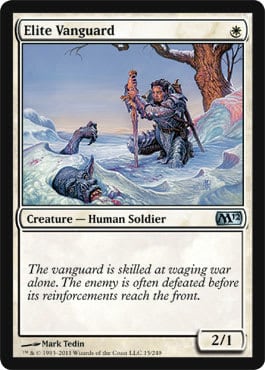
For this reason, I highly recommend you only start teaching children with Magic decks that incorporate a single color of mana.
Next Step: Try adding a second color of mana to the deck once the child is comfortable with a single color.
Advanced Level: You may add a 3rd color of mana, but I don’t recommend any more than 3.
4 colors or more are hard for even experienced Magic players to manage.
2. Only Use Creature Spells
Build decks that only contain creature spells. A good understanding of how combat works in Magic The Gathering is vital for learners to grasp.
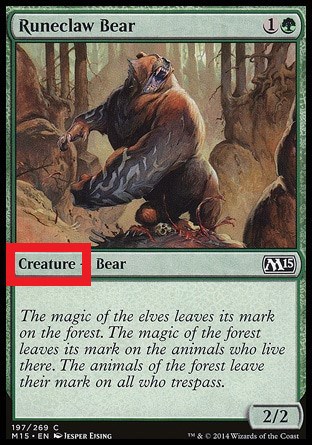
Almost all games of Magic to some extent will center around combat taking place between creatures and damage being done to a player’s life total.
Next Step: Begin to slowly add other permanent card types (“Enchantment”, “Artifact”, “Planeswalker“) one at a time and then introduce “Sorcery”.
Advanced Level: Introduce the card type “Instant” last as this will require your child to develop an understanding of how the “Stack” works in Magic The Gathering.
3. Disregard Abilities and Keywords On Creatures
Make sure that your child has a good understanding of how combat works before you have them focus on the passive and active abilities of creatures.
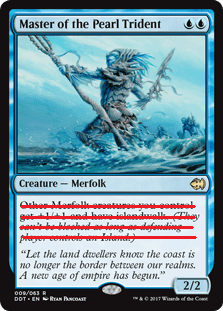
In the beginning, it’s best to have your child only pay attention to “Mana Cost“, “Power“, and “Toughness” when learning the game.
Next Step: Introduce the most commonly seen “keywords” on cards one at a time. (Trample, Haste, Vigilance, Flying, Lifelink, Deathtouch, First strike, etc).[6]
Advanced Level: Once all commonly seen Keywords have been understood, you can begin to introduce ability text on creature cards.
4. Keep Turns Simple
For the vast majority of the time you spend teaching a child the rules of Magic The Gathering, you should keep turns to 5 basic steps.
- Upkeep
- Main Phase 1
- Combat
- Main Phase 2
- End Step
Next Step: Introduce all other Phases one at a time such as the “Pre-Combat” and “Post-Combat” phase.
Advanced Level: After the previous step is completed and you have already introduced your child to the “Stack” through “Instant” spell types, you can then begin to teach them about “passing priority” between turn phases.
5. Keep Decks Small
Keep decks between 20 to 30 cards each. You may choose when starting to teach Magic to have a separate “deck” for mana and have each player draw a card from both their normal deck and their “mana deck” each turn.
Next Step: Combined your Mana and other cards into a single deck and increase the size of the deck to 40, 50, and then 60 cards.
Advanced Level: As one of the last steps in teaching a child to play Magic, introduce them to the concept of a “Sideboard” with pre-built sideboards for the decks you are playing with.
When your child is up to speed and can play a simple game of Magic, you can start adding any of the other aspects back into the game mentioned above one at a time.
For instance, after you have played 20 or so games with just creatures, you can add different spell types like enchantments or artifacts.
It is mainly up to your discretion on what you should add first in order to progress with your child, and these are not hard and fast rules.
The most important thing to pay attention to is how often the child you are playing with gets confused.
If you find after 20 or so games, ideally spread out over a few days, that your child still getting confused by some new rules then don’t be afraid to slow down.
You can always remove elements of the game that you have added a little too quickly that appear to be causing them to feel a little overwhelmed, but I strongly recommend that you only change/reintroduce 1 new rule of Magic at a time.
This will help you avoid running into too many roadblocks on your child’s path to learning how to play Magic The Gathering.
If your child is at a level where they can play but still needs guidance, you can start introducing multiplayer formats to get the entire family involved. This will allow your child to focus more on the strategy elements of the game once they have gotten used to the basic mechanics.
This is great because not only are you spending quality time with your family, but you all get to enjoy and learn Magic The Gathering together.
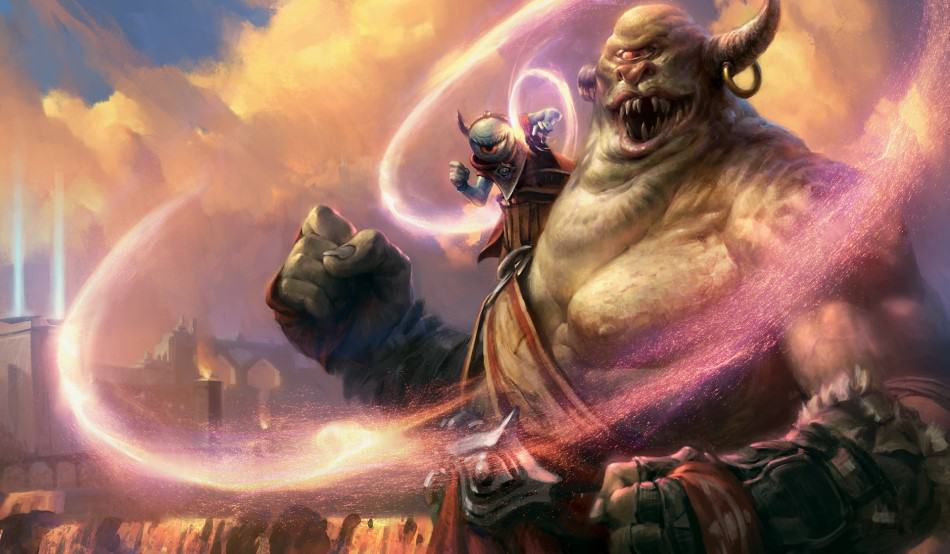
Magic The Gathering Format: Two-Headed Giant
Besides making the rules more simplistic for your kids in order for them to learn the game, there is a format of magic that allows you to play with your child as a team. This will allow you every turn to discuss and explain strategies and tactics with your child.
The format is called “Two-Headed Giant“, and it works just like most other multiplayer formats with some slight differences in rules.
This format of Magic The Gathering is multiplayer and requires teams to play. The concept is that two-player teams do battle against each other. Do take note that each team will take action as a team rather than as individuals.
The amount of teams is up to your discretion, but I suggest keeping things simple and sticking with only 2 teams to start.
Some of the rules for this multiplayer format are a little bit different than other multiplayer formats, and I’ve listed them below:
- Teams will have a shared life total that will start at 30
- Teams take turns together (draw together, attack together, block together, etc.)
- A team will not share any other resource other than life.
- Teams may share information and create strategies with each other
- The initial mulligan is to seven cards, and after that, the result is one card less
A team will lose if:
- Their life total reaches 0 or less
- If they accumulate 15 or more poison counters
- When either team member runs out of cards to draw.
With regards to damage, the loss of life through combat or spells will happen to individual players; however, any loss of life will be applied to the team’s shared life total.
Effects and abilities that read “each player” or “each opponent” will affect each team member separately.
Those are the basic rules of Two-Headed Giant, which is a great way to help your kid learn to play Magic The Gathering.
For more info on the rules, check out the MTG Rules and Formats Page.
How To Teach Kids Magic The Gathering Under 8 Years Old
Magic Junior
So we covered how to make the rules for MTG much simpler and then introducing new spells, concepts, and mechanics when your kids have a firm handle on how to play. Playing and teaching Magic this way, will normally work best for children typically 8 years old and above.
On the other hand, Magic Junior is meant for kids of a very young age and is a Magic type of game with very simplistic rules and cute pictures.
It is content that is made by parents who love Magic The Gathering and wanted to introduce it so kids from the age of 3 and up can play.
Attention: Before we continue, it is essential to note that “Magic Junior” is not produced by, endorsed by, supported by, or affiliated with Wizards of the Coast. It is fan-made content permitted under Wizards of the Coast’s fan content policy.
The game simplifies the essential concepts of MTG, and it boasts that it provides a crucial stepping stone to help very young players in understanding the game.
As you would have guessed, the rules are a little different and made much more accessible for kids to understand.The following are the basic rules:
- All spells are sorceries
- Creatures are called “Friends.”
They do not have toughness, and at a basic level, the power of a Friend will always match its casting cost - Summoning sickness is referred to as “Tired,” and it has a counter.
The same rules of summoning sickness apply, and at the beginning of a turn, the “Tired” counter is removed from any creature that may have one. - Lands are called “castles,” and each deck consist of five
- Decks have two colors
- One Castle card can be tapped for either color
- At level zero, no card will cost more than three mana (castles)
Other rules include that a parent should play with a child, but they also state that they can play with each other when the kid achieves a basic competency level without any assistance.
What’s more incredible about this game is that the developers have actually made downloadable PDFs of the cards that you can print and play with. There is no need to make your own or use your actual Magic The Gathering cards.
The PDFs represent one pack of cards, and you will need two packs to create one deck. Each pack includes;
- 6 Friend cards
- 4 Spell cards
- 2 Castle cards
- 1 Dual Castle card
- 1 Child boss or 1 Adult boss card (known as a kid or captain)
- Additional life counter card
These cards are even available in 4 languages (although only two are available for download).
You can find the PDF downloadable files for the packs for the decks here. If you are really keen to get your child into Magic The Gathering, but think they may be a bit too young, then this is an avenue you may want to look into.
What Age is Appropriate For Magic The Gathering?
On average, the appropriate age for Magic The Gathering is 13 years old. This age recommendation comes from Wizards of the Coast, the manufactures of the game. However, many players begin learning to play at a younger age, and children as young as 4 years old have been known to start playing MTG.
For the most part, Magic the Gathering thrives on involving younger players on a social and competitive level as it helps to grow the player base and ensure the longevity of the game.
Magic The Gathering is a great game that anyone, of any age, can enjoy if they take the time to learn a few of the game’s basic rules. There should be no divide based on age, which can be seen by the fact that most competitive MTG tournaments are not divided into age groups.
When playing Magic The Gathering you will come across phenomenal and gifted players no matter how long they have been playing or what age they are.
For example, “Brian Kibler“[3] began his professional Magic The Gathering career at the age of 15 years old. If Brian had never started playing MTG from such a young age, then Magic might have lost one of its world’s top players.[2]
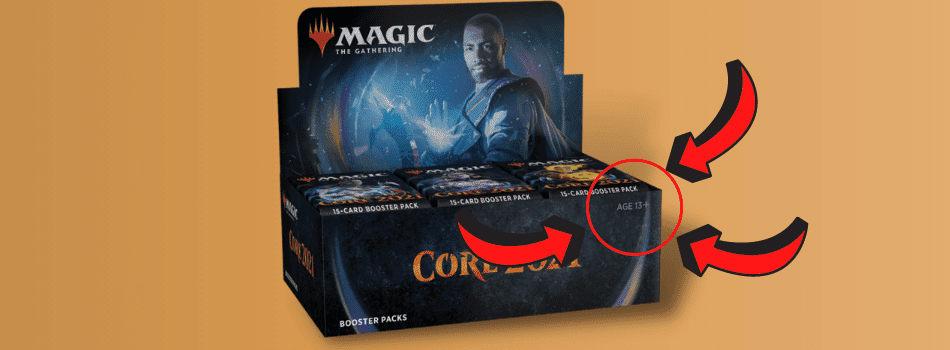
Why is Magic The Gathering 13+?
Magic The Gathering is rated 13+ due to the Motion Picture Association creating the “PG-13” rating in 1984. This reform in movie ratings to warn parents that “Some Material May Be Inappropriate for Children Under 13” was also adopted by the gaming industry to help avoid potential lawsuits.
However, the recommendation of playing Magic The Gathering at the age of 13 is not a rule, and Wizard of the Coast has stated that it is only their general suggestion.[1]
Although it is true, some children under the age of 13 years old may struggle to grasp all of Magic’s game mechanics, this recommended age of 13 years old from Wizards of the Coast is likely only due to legal concerns.
There are many legal restrictions for companies that actively try to promote their products to very young children and to avoid any unnecessary risks, businesses will raise the recommended age of their products.
Therefore, the recommended age provided by Wizards of the Coast isn’t all that helpful when trying to decide what age is best and what method should be used when starting to teach children how to play Magic The Gathering.
A fantastic example of a player that started playing Magic The Gathering when they were only 4 years old is “Dana Fischer“.
Dana Fischer is an American Magic: The Gathering player who is tied for the youngest player to make day 2 of a Grand Prix tournament (8 years old)[4] and is the youngest player ever to win a cash price at a Magic The Gathering Grand Prix event (9 years old).[5]
She is a great example that shows us that we should be less concerned with the age of the child learning to play Magic The Gathering and focus more on the method that the game is introduced by.
If you are interested in learning more about Dana’s story and how learning Magic The Gathering became a bonding experience between her and her father, click to watch the short documentary below.
Difficulties When Teaching A Child Magic The Gathering
Magic The Gathering requires patience, mathematics, strategy, communication skills, comprehension of English, and a fair bit of logical reasoning, among many other things.
Sometimes you will see kids grasp the basic understanding of the game quickly but typically, they won’t be playing with any intense combo decks. Rather, you will find most young children playing with a standard run-of-the-mill creature deck with a rare here and there to bring the deck together, building on a theme.
It all depends on the child and how much they can take in.
For the most part, parents who try and teach their kids Magic need to deal with one specific factor: concentration.
Kids are always up and about, getting bored and distracted easily.
Hence, it really wouldn’t matter what age your child is, but instead if they can sit down and focus for 20-30 minutes.
If they can concentrate enough and understand just the basics of a game of Magic, then any difficulties you’ll face while trying to teach a child will typically be overcome with a little bit of patience and repetition of games.
This does not mean they will understand all the rules and complex mechanics in one sitting, however, if they can focus, you could essentially teach them simple aspects of the game that would allow them to start play.
Take into consideration that the child’s age will play a factor, but all children are different.
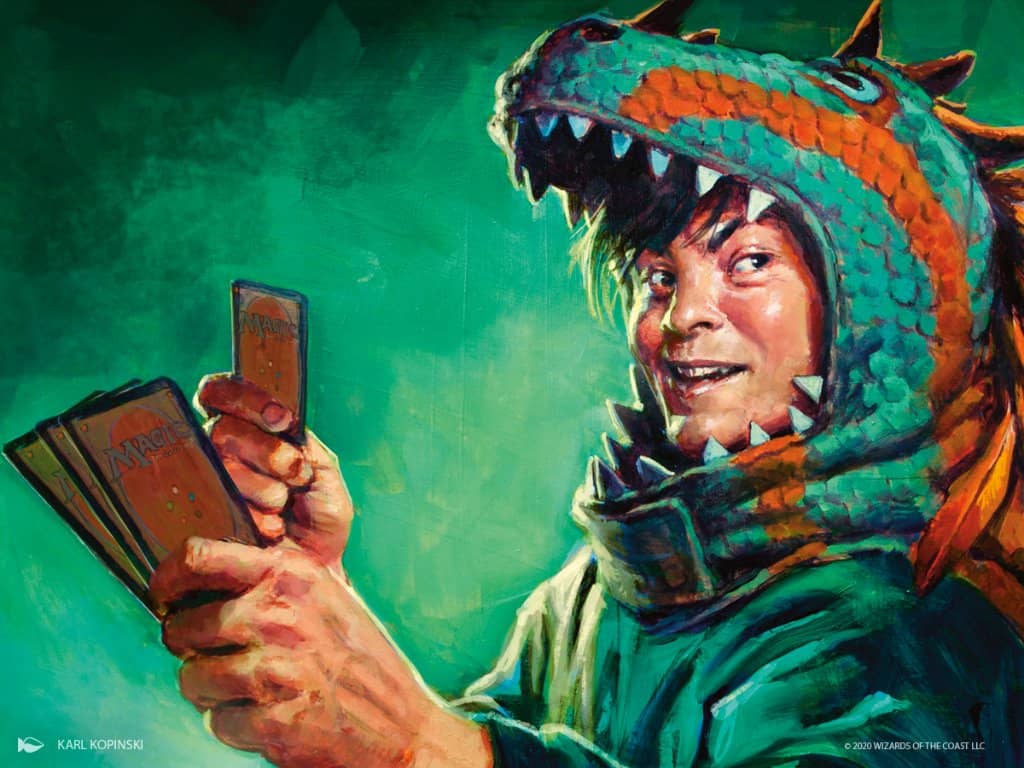
How Long Will A Child Play Magic The Gathering For?
Magic the Gathering is a game that is over a quarter of a century old, and in 2023 it will turn 30. MTG has been around for a long time. Most of the individuals who started playing back in 1993 were typically college students who have now moved on in life, gotten married, and may have kids of their own.
You only have to search #mtgdad on Twitter to get a glimpse of the first generation of Magic The Gathering players.
More likely than not, many of these individuals still play Magic The Gathering as a hobby to this day.
Even if it’s only on a casual basis like at FNM (Friday Night Magic) or any other social MTG get-together. For the most part, avid Magic The Gathering players love the camaraderie and the friendships they build when getting to play with other players.
Some individuals who have never played Magic The Gathering may think that the game is too complicated making it not kid-friendly, but this couldn’t be further from the truth.
The Magic The Gathering community is rampant, with young players of all ages playing on a social and competitive level.
Hopefully, this article helped to point you in the right direction if you are looking to teach a child or a young loved one about the wonders of Magic The Gathering.
If you know nothing about Magic The Gathering and your child has taken a liking to the game, hopefully, this article made you realize that learning the game yourself isn’t too hard, and maybe playing together with your child can act as a great parent-child bonding activity!
References
[1]Morris, P. (2018). Underage Magic Players.
[3]MAGIC: THE GATHERING. (2013). BRIAN KIBLER – HALL OF FAME – TOP PLAYERS.
[4]Jeff Zevely (Reporter (2019). Magic: The Gathering’s 8-year-old card shark.
[5]carolinianweb (2020). Magic Phenom: Dana Fischer Becomes Youngest Player to Win Cash.
[6]Mark Rosewater. (2019). Blogatog.
MAGIC: THE GATHERING. (2013). Magic: The Parenting.
MAGIC: THE GATHERING. (2013). #MTGDad.
Magic-jr.com. (2019). Magic Junior – Sharing Magic with Kids.
